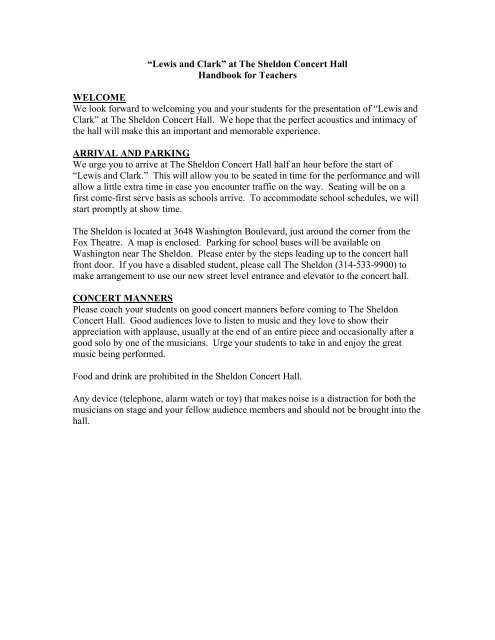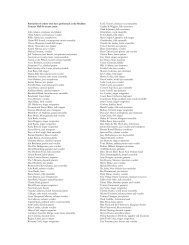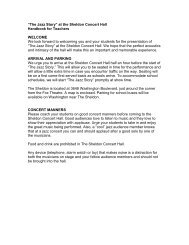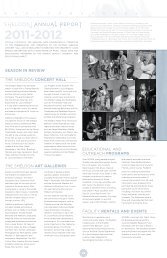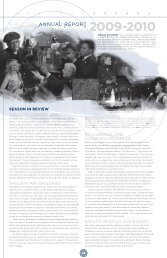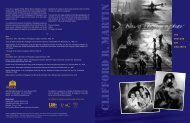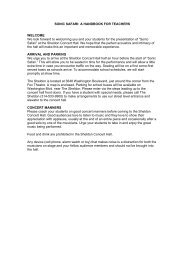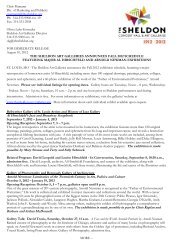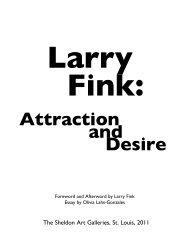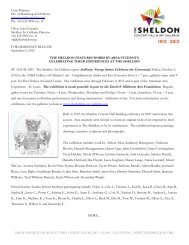“Lewis and Clark” at The Sheldon Concert Hall Handbook for ...
“Lewis and Clark” at The Sheldon Concert Hall Handbook for ...
“Lewis and Clark” at The Sheldon Concert Hall Handbook for ...
You also want an ePaper? Increase the reach of your titles
YUMPU automatically turns print PDFs into web optimized ePapers that Google loves.
<strong>“Lewis</strong> <strong>and</strong> <strong>Clark”</strong> <strong>at</strong> <strong>The</strong> <strong>Sheldon</strong> <strong>Concert</strong> <strong>Hall</strong><br />
H<strong>and</strong>book <strong>for</strong> Teachers<br />
WELCOME<br />
We look <strong>for</strong>ward to welcoming you <strong>and</strong> your students <strong>for</strong> the present<strong>at</strong>ion of <strong>“Lewis</strong> <strong>and</strong><br />
<strong>Clark”</strong> <strong>at</strong> <strong>The</strong> <strong>Sheldon</strong> <strong>Concert</strong> <strong>Hall</strong>. We hope th<strong>at</strong> the perfect acoustics <strong>and</strong> intimacy of<br />
the hall will make this an important <strong>and</strong> memorable experience.<br />
ARRIVAL AND PARKING<br />
We urge you to arrive <strong>at</strong> <strong>The</strong> <strong>Sheldon</strong> <strong>Concert</strong> <strong>Hall</strong> half an hour be<strong>for</strong>e the start of<br />
<strong>“Lewis</strong> <strong>and</strong> Clark.” This will allow you to be se<strong>at</strong>ed in time <strong>for</strong> the per<strong>for</strong>mance <strong>and</strong> will<br />
allow a little extra time in case you encounter traffic on the way. Se<strong>at</strong>ing will be on a<br />
first come-first serve basis as schools arrive. To accommod<strong>at</strong>e school schedules, we will<br />
start promptly <strong>at</strong> show time.<br />
<strong>The</strong> <strong>Sheldon</strong> is loc<strong>at</strong>ed <strong>at</strong> 3648 Washington Boulevard, just around the corner from the<br />
Fox <strong>The</strong><strong>at</strong>re. A map is enclosed. Parking <strong>for</strong> school buses will be available on<br />
Washington near <strong>The</strong> <strong>Sheldon</strong>. Please enter by the steps leading up to the concert hall<br />
front door. If you have a disabled student, please call <strong>The</strong> <strong>Sheldon</strong> (314-533-9900) to<br />
make arrangement to use our new street level entrance <strong>and</strong> elev<strong>at</strong>or to the concert hall.<br />
CONCERT MANNERS<br />
Please coach your students on good concert manners be<strong>for</strong>e coming to <strong>The</strong> <strong>Sheldon</strong><br />
<strong>Concert</strong> <strong>Hall</strong>. Good audiences love to listen to music <strong>and</strong> they love to show their<br />
appreci<strong>at</strong>ion with applause, usually <strong>at</strong> the end of an entire piece <strong>and</strong> occasionally after a<br />
good solo by one of the musicians. Urge your students to take in <strong>and</strong> enjoy the gre<strong>at</strong><br />
music being per<strong>for</strong>med.<br />
Food <strong>and</strong> drink are prohibited in the <strong>Sheldon</strong> <strong>Concert</strong> <strong>Hall</strong>.<br />
Any device (telephone, alarm w<strong>at</strong>ch or toy) th<strong>at</strong> makes noise is a distraction <strong>for</strong> both the<br />
musicians on stage <strong>and</strong> your fellow audience members <strong>and</strong> should not be brought into the<br />
hall.
Lewis <strong>and</strong> Clark/H<strong>and</strong>book <strong>for</strong> Teachers – page 2<br />
DEFINITIONS<br />
Folk music<br />
Folk music is the music sung <strong>and</strong> played by the common folk or people of a particular<br />
community or country. <strong>The</strong> original composer of a folksong is often unknown. Folk<br />
music is often not written down, but passed on orally from one musician to another <strong>and</strong><br />
one gener<strong>at</strong>ion to another, often being changed as it’s passed along. <strong>The</strong>re are many<br />
kinds of folksongs, often dealing with daily life – work songs, love songs, cradle songs,<br />
drinking songs, p<strong>at</strong>riotic songs, dancing numbers <strong>and</strong> frolic tunes, mourning songs <strong>and</strong><br />
epic tales.<br />
Ballad<br />
A ballad is a song th<strong>at</strong> tells a story. Some ballads deal with legendary characters,<br />
miraculous happenings or gruesome deeds, while others tell romantic tales or chronicle<br />
an historical event.<br />
Work song<br />
Workers, to coordin<strong>at</strong>e their ef<strong>for</strong>ts <strong>and</strong> to keep their spirits up in the face of hard<br />
physical labor, sing work songs. African-American slaves sang work songs as they<br />
ploughed <strong>and</strong> harvested the l<strong>and</strong> of the South, cut down trees <strong>and</strong> split the logs, worked<br />
the mules along muddy rivers <strong>and</strong> hoisted cotton bales onto Mississippi steambo<strong>at</strong>s.<br />
Work songs have been sung by sailors <strong>and</strong> other workers <strong>for</strong> centuries.<br />
Jig<br />
A lively dance, often in 6/8 or 2/4 time<br />
Sea Chantey<br />
A song sung by sailors to accompany work or <strong>for</strong> fun.<br />
Clogging<br />
An American percussive folkdance th<strong>at</strong> origin<strong>at</strong>ed in the southern Appalachian<br />
mountains. It has strong ties to the stepdancing in the British Isles <strong>and</strong> has been<br />
influenced by both traditional American Indian dances <strong>and</strong> “buck <strong>and</strong> wing” dancing by<br />
African American slaves.
Lewis <strong>and</strong> Clark/H<strong>and</strong>book <strong>for</strong> Teachers – page 3<br />
INSTRUMENTS used in <strong>“Lewis</strong> <strong>and</strong> <strong>Clark”</strong><br />
(<strong>The</strong> names of the instruments <strong>and</strong> definitions can be jumbled <strong>and</strong> used as a m<strong>at</strong>ching<br />
exercise <strong>for</strong> your students.)<br />
Fiddle<br />
<strong>The</strong> name <strong>for</strong> a violin when played by folk, country, bluegrass <strong>and</strong> other acoustic<br />
musicians. <strong>The</strong> violin has four strings <strong>and</strong> is a member of a family of bowed string<br />
instruments th<strong>at</strong> also includes the viola, cello <strong>and</strong> double bass.<br />
Guitar<br />
A plucked or strummed string instrument originally brought to Spain by the Moors in the<br />
Middle Ages. This instrument, usually with six strings <strong>and</strong> occasionally with twelve<br />
strings, became popular with both blues <strong>and</strong> folk singers to accompany their singing.<br />
Drum<br />
A percussion instrument common to many cultures, consisting of an animal skin, or<br />
synthetic equivalent, stretched over a wooden frame <strong>and</strong> struck by the h<strong>and</strong> or a be<strong>at</strong>er.<br />
Spoons<br />
Two spoons, often made of animal horn or steel, th<strong>at</strong> are held together <strong>and</strong> struck against<br />
the body <strong>for</strong> percussive sounds.<br />
Fiddle Sticks<br />
Small thin sticks struck against the strings of a fiddle, cre<strong>at</strong>ing a light percussive sound.<br />
Sounded Horn<br />
A tin horn used by bo<strong>at</strong>men <strong>and</strong> hunters to communic<strong>at</strong>e when out of sight.<br />
Basket R<strong>at</strong>tle<br />
A small basket filled with seeds <strong>and</strong> shaken as a percussion instrument.<br />
Hoof R<strong>at</strong>tle<br />
Deer or go<strong>at</strong> hooves strung on rawhide or rope <strong>and</strong> used as a r<strong>at</strong>tle.<br />
Wood Clacker<br />
Small circular pieces of wood on a stick <strong>and</strong> shaken as a percussion instrument.
Lewis <strong>and</strong> Clark/H<strong>and</strong>book <strong>for</strong> Teachers - page 4<br />
ACTIVITIES<br />
Ask your students to trace the p<strong>at</strong>h of the Corps of Discovery <strong>and</strong> to name the st<strong>at</strong>es th<strong>at</strong><br />
now encompass these l<strong>and</strong>s - Illinois, Missouri, Kansas, Iowa, Nebraska, South Dakota,<br />
North Dakota, Montana, Idaho, Washington <strong>and</strong> Oregon.<br />
Although they found th<strong>at</strong> there was not an all-w<strong>at</strong>er route to the Pacific Ocean, the Corps<br />
did travel most of the way on rivers. Name the rivers th<strong>at</strong> the Corps traveled - Ohio<br />
River (Meriwether Lewis traveled from Pittsburgh to Louisville where he met Clark),<br />
Mississippi River, Missouri River, Columbia River <strong>and</strong> Yellowstone River (on the return<br />
route, Clark took a part of the party down the Yellowstone to the Missouri while Lewis<br />
explored the Marias River).<br />
Members of the Corps used music to entertain themselves <strong>and</strong> to entertain the Indians.<br />
Several instances of music are recorded in their journals:<br />
“<strong>The</strong> two Chiefs much pleased with ther tre<strong>at</strong>ment & the Cherfulness of the<br />
party, who Danced to amuse them.”<br />
William Clark November 27, 1804<br />
“the fiddle was plyed <strong>and</strong> they danced very merrily until 9 in the evening<br />
when a heavy shower of rain put an end to th<strong>at</strong> part of the amusement tho’<br />
they continued their mirth with songs <strong>and</strong> festive jokes <strong>and</strong> were extremely<br />
merry until l<strong>at</strong>e <strong>at</strong> night.”<br />
Meriwether Lewis July 4, 1805<br />
“a little be<strong>for</strong>e sun set the Chimnahpoms arrived; they were about 100 men<br />
<strong>and</strong> a few women; they joined the Wallahwallahs … <strong>and</strong> <strong>for</strong>med a half<br />
circle around out camp where they waited p<strong>at</strong>iently to see our party dance.<br />
the fiddle was played <strong>and</strong> the men amused themselves with dancing …<br />
we then requested the Indians to dance which they very cheerfully<br />
complied with; they continued their dance until 10 <strong>at</strong> night … Some of the<br />
men who were esteemed most brave entered the space … <strong>and</strong> danced …<br />
they were much gr<strong>at</strong>ified in seeing some of our party join them in their dance.”<br />
William Clark April 28, 1806<br />
Do your students make music in their daily lives?<br />
If so, how <strong>and</strong> when?<br />
<strong>The</strong> Corps left Camp Dubois near St. Louis on May 14, 1804. <strong>The</strong>y returned to St. Louis<br />
over two years <strong>and</strong> three months l<strong>at</strong>er on September 23, 1806. Ask your students how<br />
long it takes to drive today from St. Louis to Portl<strong>and</strong>, Oregon. How long is an airplane<br />
flight from St. Louis to the West Coast?
Lewis <strong>and</strong> Clark/H<strong>and</strong>book <strong>for</strong> Teachers - page 5<br />
<strong>The</strong> Corps met nearly fifty tribes of American Indians on their trip. How many tribes can<br />
your students name?<br />
Alsea Indians<br />
Amahami Indians<br />
Arikara Indians<br />
(Sahnish)<br />
Assiniboin Indians<br />
Atsina Indians<br />
(Gros Ventre)<br />
Bannock Indians<br />
Blackfeet Indians<br />
C<strong>at</strong>hlamet Indians<br />
Cayuse Indians<br />
Chehalis Indians<br />
Cheyenne Indians<br />
Chinook Indians<br />
Clackamas Indians<br />
Cl<strong>at</strong>skamas Indians<br />
Cl<strong>at</strong>skanie Indians<br />
Cl<strong>at</strong>sop Indians<br />
Cowlitz Indians<br />
Crow Indians<br />
(Absaroka)<br />
Fl<strong>at</strong>head Indians (Salish)<br />
Hid<strong>at</strong>sa Indians<br />
Kickapoo Indians<br />
Klickit<strong>at</strong> Indians<br />
Kootenai Indians<br />
M<strong>and</strong>an Indians<br />
Minitari Indians<br />
Missouri Indians<br />
Multnomah Indians<br />
Nez Perce Indians<br />
Omaha Indians<br />
Oto Indians<br />
Palouse Indians<br />
Pawnee Indians<br />
Quinault Indians<br />
Shoshone Indians<br />
(Snake)<br />
Siletz Indians<br />
Siuslaw Indians<br />
Skilloot Indians<br />
Tenino Indians<br />
Teton Sioux Indians<br />
Tillamook Indians<br />
Um<strong>at</strong>illa Indians<br />
Umpqua Indians<br />
Wahkiakum Indians<br />
Walla Walla Indians<br />
Wanapum Indians<br />
Wasco Indians<br />
Wishram Indians<br />
Yakima Indians<br />
Yankton Sioux Indians
Lewis <strong>and</strong> Clark/H<strong>and</strong>book <strong>for</strong> Teachers - page 6<br />
MUSICAL SELECTIONS IN “LEWIS AND CLARK”<br />
Bonaparte’s Retre<strong>at</strong> - a traditional fiddle tune<br />
Endearing Young Charms - an air published in Engl<strong>and</strong> in 1775, this waltz is a<br />
favorite of fiddlers.<br />
Back on the River - original song written by Annie Scheumbauer, <strong>for</strong> sing-along<br />
Whiskey Be<strong>for</strong>e Breakfast - Irish fiddle tune<br />
Possum Tail<br />
Soldiers Joy - possibly the best known fiddle tune in history. Early versions<br />
can be traced to Scotl<strong>and</strong> in 1781. In Engl<strong>and</strong> it is also known as “<strong>The</strong> King’s<br />
Head” <strong>and</strong> some oldtimers in Missouri call it “Payday in the Army.”<br />
Yankee Dooddle<br />
Song of Sacagawea - original song written by Annie Scheumbauer<br />
Shen<strong>and</strong>oah - long-time favorite folk song<br />
Pass on By - song about mosquitoes <strong>and</strong> grizzly bears written by John Higgins<br />
Over the W<strong>at</strong>erfall - fiddle tune<br />
Blow the Man Down - sea chantey<br />
Travellin’ Home - original song written by Annie Scheumbauer
Lewis <strong>and</strong> Clark/H<strong>and</strong>book <strong>for</strong> Teachers - page 7
Lewis <strong>and</strong> Clark/H<strong>and</strong>book <strong>for</strong> Teachers - page 8<br />
Back on the River / Spirit of Discovery Annie Scheumbauer © 2003<br />
As we step off from this shore<br />
We’re setting off to explore<br />
This new l<strong>and</strong> <strong>and</strong> the wonders th<strong>at</strong> lie ahead<br />
To follow the river we’ve been sent<br />
By order of the President<br />
As it makes its way towards ocean’s shore<br />
Chorus:<br />
Back on the river we go, we go<br />
Back on the river we go<br />
We camp out every night <strong>and</strong> can’t wait till morning’s light<br />
When it’s back on the river we go<br />
As we travel on our way<br />
We make notes every day<br />
About the plants <strong>and</strong> animals th<strong>at</strong> we see<br />
W<strong>at</strong>ching the heavens every night<br />
Plotting our course by the stars so bright<br />
Drawing maps of the places where we’ve been<br />
Chorus<br />
<strong>The</strong> sounds of n<strong>at</strong>ure fill our day<br />
As we row on our way<br />
Keepin’ time with the oars’ splashing sound<br />
<strong>The</strong> song of birds fill the air<br />
<strong>The</strong> buzz of mosquitoes everywhere<br />
And the wind whistlin’ through the trees<br />
Chorus<br />
We’re not sure wh<strong>at</strong> lies ahead<br />
By our dreams we are led<br />
To adventures round the next bend<br />
We’re driven you see<br />
By this spirit of discovery<br />
To blaze the trail <strong>for</strong> travelers yet to come<br />
Chorus (End: repe<strong>at</strong> 3x as fade away)
Lewis <strong>and</strong> Clark/H<strong>and</strong>book <strong>for</strong> Teachers - page 9<br />
THE MUSICIANS<br />
John Higgins currently per<strong>for</strong>ms with the folk <strong>and</strong> bluegrass group “<strong>The</strong> Flying Mules.”<br />
He has played guitar <strong>for</strong> 35 years <strong>and</strong> toured throughout the United St<strong>at</strong>es. He is an avid<br />
student of guitar history <strong>and</strong> builds custom guitars.<br />
Annie Scheumbauer is a singer <strong>and</strong> guitarist who per<strong>for</strong>ms with the Folk Trio <strong>for</strong> Young<br />
Audiences. She is also a painter <strong>and</strong> art teacher <strong>at</strong> Ursiline Academy, a clog dancer, <strong>and</strong><br />
a composer who has written three songs <strong>for</strong> the <strong>“Lewis</strong> <strong>and</strong> <strong>Clark”</strong> program. Her painted<br />
backdrops are used behind the musicians on <strong>The</strong> <strong>Sheldon</strong> stage.<br />
Ted Vasquez is a fiddle player who specializes in old time fiddle tunes. He has been<br />
studying old time music <strong>for</strong> over 15 years <strong>and</strong> he plays regularly <strong>for</strong> square dances <strong>and</strong><br />
contradances in the St. Louis area.<br />
Credits:<br />
<strong>The</strong> tin “sounded horn” used in our program was made by Ken Berkel <strong>at</strong> Berkel Sheet<br />
Metal.<br />
<strong>The</strong> drum was made of wood <strong>and</strong> animal skin by John Higgins.<br />
<strong>The</strong> h<strong>at</strong>, like th<strong>at</strong> worn by Pierre Cruz<strong>at</strong>te, was h<strong>and</strong> knit by Dana St. John.<br />
<strong>The</strong> h<strong>and</strong>-painted silk backdrops were cre<strong>at</strong>ed by Annie Scheumbauer.<br />
Original music was written by Annie Scheumbauer <strong>and</strong> John Higgins.


